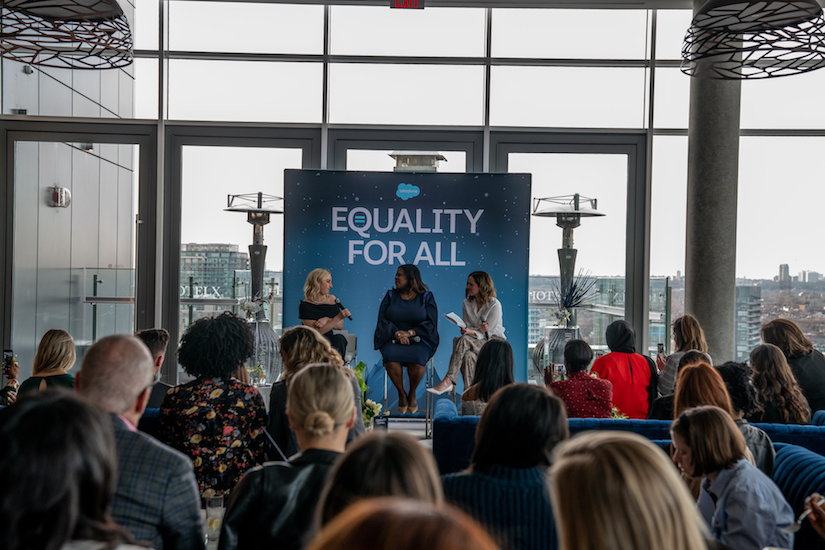Not-so-fun fact: Just 5 percent of tech CEO positions in Canada are held by women. There are slightly more of us—13 percent to be exact—in senior roles. Yes, in 2019. It’s figures like that that have us desperately searching for ways to create more equitable workplaces, regardless of the industry.
Enter: Molly Ford, senior director of global diversity programs at software company Salesforce and Torontonian Jodi Kovitz, founder and CEO of #MoveTheDial, a movement dedicated to the advancement of women in the tech industry. On the eve of World Tour Toronto, Salesforce’s largest annual event in Canada, the two industry leaders gathered at Toronto’s Hotel X on April 10 for Equality For All, a panel discussion hosted by the tech company and moderated by ELLE Canada managing editor Carli Whitwell, to discuss how organizations have to become more inclusive and what challenges still need to be overcome.
Here are five things we learned at the panel.
1. It’s time to start “she-peating”
“We’re talking about ‘he-peating’ a lot right now,” Ford says, referring to the frustrating and all-too-common occurrence where a man is praised in a meeting for reiterating an idea that was ignored when it came from a woman earlier. “We’re going to ‘she-peat’ now. If a woman says something, we acknowledge it, we repeat it and we give her credit for it.”
2. Increasing inclusivity is a full-time job
“The work of equality is not a side hustle. There are so many people who know how do equality work [on the] side because they deeply care about it,” Kovitz says. “But [at work], it’s not part of their goal description, they don’t get compensated and they don’t have a dedicated budget for it. For me, that’s not all in. We need to go all in and fund and invest in equality.”
3. Men have to be part of the conversation too
“Ladies, stop waiting for a mentor who looks like you—I especially say that to women of colour. We can’t all wait for that,” Ford says, adding that, actually, finding allyship from men in the industry is just as important as having a female support system (though you need that too). “Disproportionately, men are the leaders. They want to lean in—give them the opportunity and ask a man to be your mentor. You want someone who’s got skin in the game, who’s advocating for you when you’re not in the room.”
4. Rethink that coffee meeting
Pro-tip: “Asking someone for coffee to be your mentor is not a useful of anyone’s time,” Kovitz says. The search for a mentor, Kovitz explains, has to go a lot deeper. “It’s really helpful to seek out advice and input, but you still have to get to know the person and authentically connect with them to understand if they are someone who can meaningfully assist you with your goals and in your areas of interest.”
How do you achieve that? By showing up prepared and doing homework (like setting long-term goals for your future and creating actionable plans). “There has to be structure around the [mentorship] process,” Kovitz adds. “[Homework creates] attainable, small steps so the mentee can feel wins, and the person championing them can feel like they add value. And that’s a great use of our time.”
5. Learn how to be an ally
Both Ford and Kovitz agree that allyship is instrumental in creating more equality in the workplace because women move through the workplace differently—and women of colour face different challenges as well. Ford pointed out four key things for allies to keep in mind: “Allies ask people about their journey. They listen with empathy and respect. They show up and speak up for others,” she says. “And allies need to do the work. Don’t burden the first black person you see, do your education. Build an empathetic relationship where someone will take the time to teach you.”
Newsletter
Join our mailing list for the latest and biggest in fashion trends, beauty, culture and celebrity.
Read Next

Fashion
Are Fashion Brands Getting Greener?
While the fashion industry is making a lot of noise about being more sustainable, a closer look shows that its earth-friendly commitments are often more illusion than reality.
by : Marouchka Franjulien- Apr 19th, 2024

Beauty
What Beauty Packaging Is Actually Sustainable?
We sought out leaders in the field to help us get to the bottom of the blue bin once and for all.
by : Victoria Christie- Apr 19th, 2024

Culture
ELLE Escapes: Savannah
Where to go, stay, eat and drink in “the Hostess City of the South.”
by : ELLE- Apr 15th, 2024





